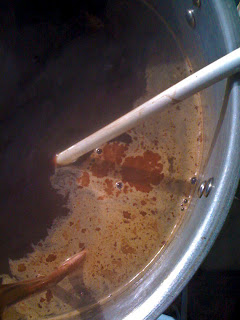An inventory of my grain bill for the recipe got me to thinking about the black and Carafa® 2 malts. The are really quite black, and probably a bit smoky/bitter in a full mash. Then I remembered I had seen mention of cold steeping the black adjunct grains as a way to extract the black color without much burnt flavor characteristic coming through. Friday night I combed the homebrew forums and club websites, until I came across a description for cold steeping black adjunct malts by George Fix of Eugene Oregon's Cascade Brewing Society, posted sometime after 2007.
Cold Steeping Black Adjunct Malts
Here are the steps as I adapted for my recipe:
- Boil 1/2 gallon of water per 1 1/2 lb. of grains to be steeped for 5 mins.
- Cool the water down to ambient, and add the cracked grains in a cloth grain bag.
- Let steep for 12 hrs. at ambient temperature, then rinse the grains in the bag with 1 pint of 170 F water at the same time as the rest of the mini-mash.
- Add to the rest of the mash in the brew kettle and begin the boil.
 |
| Self portrait in my brewing kettle thermometer. |
 |
| India Black Ale nears the end of its boil. |
By yeast pitching time, the beer's OG was pretty high at 1.076, probably due to the 12 oz. of cane sugar in my recipe. This will probably get converted to a slightly higher alcohol level than my predicted 5.4%. The taste of the OG test beer was deliciously sweet, and slightly roasted, but more of a dark caramel than a burnt-peat stout in flavor. My hope is the final conditioned bottle of beer will taste somewhere between a HUB Secession for dryness and a Southern Tier Inequity for richness.
The yeast got so active by Sunday evening the carboy's temperature rose 5 ºF to a worrisome peak of 73 ºF. For a change I found myself packing ice around the fermenter then setting it outside on the freezing concrete front step before dawn just to cool it. By Monday morning I had brought the temperature back to a safe 68 ºF. Activity has begun to slow, and some of the chocolate mouse kräusen bubbles have begun to fall. In another five days, it will be time to start dry-hopping.
No comments:
Post a Comment